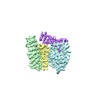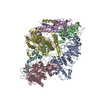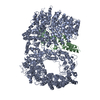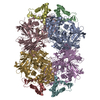+ Open data
Open data
- Basic information
Basic information
| Entry | Database: EMDB / ID: EMD-3984 | ||||||||||||
|---|---|---|---|---|---|---|---|---|---|---|---|---|---|
| Title | Human Huntingtin-HAP40 complex structure | ||||||||||||
 Map data Map data | Huntingtin-HAP40 complex | ||||||||||||
 Sample Sample |
| ||||||||||||
 Keywords Keywords | Huntingtin / HAP40/F8A / Cryo-EM / Huntington's disease / PROTEIN BINDING | ||||||||||||
| Function / homology |  Function and homology information Function and homology informationvesicle cytoskeletal trafficking / : / positive regulation of CAMKK-AMPK signaling cascade / microtubule-based transport / vocal learning / negative regulation of proteasomal protein catabolic process / positive regulation of mitophagy / regulation of CAMKK-AMPK signaling cascade / profilin binding / positive regulation of cilium assembly ...vesicle cytoskeletal trafficking / : / positive regulation of CAMKK-AMPK signaling cascade / microtubule-based transport / vocal learning / negative regulation of proteasomal protein catabolic process / positive regulation of mitophagy / regulation of CAMKK-AMPK signaling cascade / profilin binding / positive regulation of cilium assembly / retrograde vesicle-mediated transport, Golgi to endoplasmic reticulum / vesicle transport along microtubule / positive regulation of aggrephagy / positive regulation of lipophagy / Golgi organization / dynein intermediate chain binding / establishment of mitotic spindle orientation / dynactin binding / phosphoprotein phosphatase activity / Regulation of MECP2 expression and activity / postsynaptic cytosol / beta-tubulin binding / presynaptic cytosol / heat shock protein binding / inclusion body / centriole / autophagosome / cytoplasmic vesicle membrane / negative regulation of extrinsic apoptotic signaling pathway / protein destabilization / kinase binding / p53 binding / late endosome / transmembrane transporter binding / early endosome / nuclear body / positive regulation of apoptotic process / axon / apoptotic process / dendrite / perinuclear region of cytoplasm / endoplasmic reticulum / Golgi apparatus / protein-containing complex / nucleoplasm / identical protein binding / nucleus / cytoplasm / cytosol Similarity search - Function | ||||||||||||
| Biological species |  Homo sapiens (human) Homo sapiens (human) | ||||||||||||
| Method | single particle reconstruction / cryo EM / Resolution: 4.0 Å | ||||||||||||
 Authors Authors | Guo Q / Bin H | ||||||||||||
| Funding support |  Germany, Germany,  United States, 3 items United States, 3 items
| ||||||||||||
 Citation Citation |  Journal: Nature / Year: 2018 Journal: Nature / Year: 2018Title: The cryo-electron microscopy structure of huntingtin. Authors: Qiang Guo / Bin Huang / Jingdong Cheng / Manuel Seefelder / Tatjana Engler / Günter Pfeifer / Patrick Oeckl / Markus Otto / Franziska Moser / Melanie Maurer / Alexander Pautsch / Wolfgang ...Authors: Qiang Guo / Bin Huang / Jingdong Cheng / Manuel Seefelder / Tatjana Engler / Günter Pfeifer / Patrick Oeckl / Markus Otto / Franziska Moser / Melanie Maurer / Alexander Pautsch / Wolfgang Baumeister / Rubén Fernández-Busnadiego / Stefan Kochanek /  Abstract: Huntingtin (HTT) is a large (348 kDa) protein that is essential for embryonic development and is involved in diverse cellular activities such as vesicular transport, endocytosis, autophagy and the ...Huntingtin (HTT) is a large (348 kDa) protein that is essential for embryonic development and is involved in diverse cellular activities such as vesicular transport, endocytosis, autophagy and the regulation of transcription. Although an integrative understanding of the biological functions of HTT is lacking, the large number of identified HTT interactors suggests that it serves as a protein-protein interaction hub. Furthermore, Huntington's disease is caused by a mutation in the HTT gene, resulting in a pathogenic expansion of a polyglutamine repeat at the amino terminus of HTT. However, only limited structural information regarding HTT is currently available. Here we use cryo-electron microscopy to determine the structure of full-length human HTT in a complex with HTT-associated protein 40 (HAP40; encoded by three F8A genes in humans) to an overall resolution of 4 Å. HTT is largely α-helical and consists of three major domains. The amino- and carboxy-terminal domains contain multiple HEAT (huntingtin, elongation factor 3, protein phosphatase 2A and lipid kinase TOR) repeats arranged in a solenoid fashion. These domains are connected by a smaller bridge domain containing different types of tandem repeats. HAP40 is also largely α-helical and has a tetratricopeptide repeat-like organization. HAP40 binds in a cleft and contacts the three HTT domains by hydrophobic and electrostatic interactions, thereby stabilizing the conformation of HTT. These data rationalize previous biochemical results and pave the way for improved understanding of the diverse cellular functions of HTT. | ||||||||||||
| History |
|
- Structure visualization
Structure visualization
| Movie |
 Movie viewer Movie viewer |
|---|---|
| Structure viewer | EM map:  SurfView SurfView Molmil Molmil Jmol/JSmol Jmol/JSmol |
| Supplemental images |
- Downloads & links
Downloads & links
-EMDB archive
| Map data |  emd_3984.map.gz emd_3984.map.gz | 14.6 MB |  EMDB map data format EMDB map data format | |
|---|---|---|---|---|
| Header (meta data) |  emd-3984-v30.xml emd-3984-v30.xml emd-3984.xml emd-3984.xml | 21.5 KB 21.5 KB | Display Display |  EMDB header EMDB header |
| Images |  emd_3984.png emd_3984.png | 62.4 KB | ||
| Filedesc metadata |  emd-3984.cif.gz emd-3984.cif.gz | 8.8 KB | ||
| Archive directory |  http://ftp.pdbj.org/pub/emdb/structures/EMD-3984 http://ftp.pdbj.org/pub/emdb/structures/EMD-3984 ftp://ftp.pdbj.org/pub/emdb/structures/EMD-3984 ftp://ftp.pdbj.org/pub/emdb/structures/EMD-3984 | HTTPS FTP |
-Validation report
| Summary document |  emd_3984_validation.pdf.gz emd_3984_validation.pdf.gz | 565.6 KB | Display |  EMDB validaton report EMDB validaton report |
|---|---|---|---|---|
| Full document |  emd_3984_full_validation.pdf.gz emd_3984_full_validation.pdf.gz | 565.1 KB | Display | |
| Data in XML |  emd_3984_validation.xml.gz emd_3984_validation.xml.gz | 5.4 KB | Display | |
| Data in CIF |  emd_3984_validation.cif.gz emd_3984_validation.cif.gz | 6.2 KB | Display | |
| Arichive directory |  https://ftp.pdbj.org/pub/emdb/validation_reports/EMD-3984 https://ftp.pdbj.org/pub/emdb/validation_reports/EMD-3984 ftp://ftp.pdbj.org/pub/emdb/validation_reports/EMD-3984 ftp://ftp.pdbj.org/pub/emdb/validation_reports/EMD-3984 | HTTPS FTP |
-Related structure data
| Related structure data |  6ez8MC M: atomic model generated by this map C: citing same article ( |
|---|---|
| Similar structure data |
- Links
Links
| EMDB pages |  EMDB (EBI/PDBe) / EMDB (EBI/PDBe) /  EMDataResource EMDataResource |
|---|---|
| Related items in Molecule of the Month |
- Map
Map
| File |  Download / File: emd_3984.map.gz / Format: CCP4 / Size: 15.6 MB / Type: IMAGE STORED AS FLOATING POINT NUMBER (4 BYTES) Download / File: emd_3984.map.gz / Format: CCP4 / Size: 15.6 MB / Type: IMAGE STORED AS FLOATING POINT NUMBER (4 BYTES) | ||||||||||||||||||||||||||||||||||||||||||||||||||||||||||||
|---|---|---|---|---|---|---|---|---|---|---|---|---|---|---|---|---|---|---|---|---|---|---|---|---|---|---|---|---|---|---|---|---|---|---|---|---|---|---|---|---|---|---|---|---|---|---|---|---|---|---|---|---|---|---|---|---|---|---|---|---|---|
| Annotation | Huntingtin-HAP40 complex | ||||||||||||||||||||||||||||||||||||||||||||||||||||||||||||
| Projections & slices | Image control
Images are generated by Spider. | ||||||||||||||||||||||||||||||||||||||||||||||||||||||||||||
| Voxel size | X=Y=Z: 1.35 Å | ||||||||||||||||||||||||||||||||||||||||||||||||||||||||||||
| Density |
| ||||||||||||||||||||||||||||||||||||||||||||||||||||||||||||
| Symmetry | Space group: 1 | ||||||||||||||||||||||||||||||||||||||||||||||||||||||||||||
| Details | EMDB XML:
CCP4 map header:
| ||||||||||||||||||||||||||||||||||||||||||||||||||||||||||||
-Supplemental data
- Sample components
Sample components
-Entire : Huntingtin-HAP40 complex
| Entire | Name: Huntingtin-HAP40 complex |
|---|---|
| Components |
|
-Supramolecule #1: Huntingtin-HAP40 complex
| Supramolecule | Name: Huntingtin-HAP40 complex / type: complex / ID: 1 / Parent: 0 / Macromolecule list: all |
|---|---|
| Source (natural) | Organism:  Homo sapiens (human) Homo sapiens (human) |
| Molecular weight | Theoretical: 352 KDa |
-Macromolecule #1: Huntingtin
| Macromolecule | Name: Huntingtin / type: protein_or_peptide / ID: 1 / Number of copies: 1 / Enantiomer: LEVO |
|---|---|
| Source (natural) | Organism:  Homo sapiens (human) Homo sapiens (human) |
| Molecular weight | Theoretical: 347.475375 KDa |
| Recombinant expression | Organism:  Homo sapiens (human) Homo sapiens (human) |
| Sequence | String: MATLEKLMKA FESLKSFQQQ QQQQQQQQQQ QQQQPPPPPP PPPPPQLPQP PPQAQPLLPQ PQPPPPPPPP PPGPAVAEEP LHRPKKELS ATKKDRVNHC LTICENIVAQ SVRNSPEFQK LLGIAMELFL LCSDDAESDV RMVADECLNK VIKALMDSNL P RLQLELYK ...String: MATLEKLMKA FESLKSFQQQ QQQQQQQQQQ QQQQPPPPPP PPPPPQLPQP PPQAQPLLPQ PQPPPPPPPP PPGPAVAEEP LHRPKKELS ATKKDRVNHC LTICENIVAQ SVRNSPEFQK LLGIAMELFL LCSDDAESDV RMVADECLNK VIKALMDSNL P RLQLELYK EIKKNGAPRS LRAALWRFAE LAHLVRPQKC RPYLVNLLPC LTRTSKRPEE SVQETLAAAV PKIMASFGNF AN DNEIKVL LKAFIANLKS SSPTIRRTAA GSAVSICQHS RRTQYFYSWL LNVLLGLLVP VEDEHSTLLI LGVLLTLRYL VPL LQQQVK DTSLKGSFGV TRKEMEVSPS AEQLVQVYEL TLHHTQHQDH NVVTGALELL QQLFRTPPPE LLQTLTAVGG IGQL TAAKE ESGGRSRSGS IVELIAGGGS SCSPVLSRKQ KGKVLLGEEE ALEDDSESRS DVSSSALTAS VKDEISGELA ASSGV STPG SAGHDIITEQ PRSQHTLQAD SVDLASCDLT SSATDGDEED ILSHSSSQVS AVPSDPAMDL NDGTQASSPI SDSSQT TTE GPDSAVTPSD SSEIVLDGTD NQYLGLQIGQ PQDEDEEATG ILPDEASEAF RNSSMALQQA HLLKNMSHCR QPSDSSV DK FVLRDEATEP GDQENKPCRI KGDIGQSTDD DSAPLVHCVR LLSASFLLTG GKNVLVPDRD VRVSVKALAL SCVGAAVA L HPESFFSKLY KVPLDTTEYP EEQYVSDILN YIDHGDPQVR GATAILCGTL ICSILSRSRF HVGDWMGTIR TLTGNTFSL ADCIPLLRKT LKDESSVTCK LACTAVRNCV MSLCSSSYSE LGLQLIIDVL TLRNSSYWLV RTELLETLAE IDFRLVSFLE AKAENLHRG AHHYTGLLKL QERVLNNVVI HLLGDEDPRV RHVAAASLIR LVPKLFYKCD QGQADPVVAV ARDQSSVYLK L LMHETQPP SHFSVSTITR IYRGYNLLPS ITDVTMENNL SRVIAAVSHE LITSTTRALT FGCCEALCLL STAFPVCIWS LG WHCGVPP LSASDESRKS CTVGMATMIL TLLSSAWFPL DLSAHQDALI LAGNLLAASA PKSLRSSWAS EEEANPAATK QEE VWPALG DRALVPMVEQ LFSHLLKVIN ICAHVLDDVA PGPAIKAALP SLTNPPSLSP IRRKGKEKEP GEQASVPLSP KKGS EASAA SRQSDTSGPV TTSKSSSLGS FYHLPSYLRL HDVLKATHAN YKVTLDLQNS TEKFGGFLRS ALDVLSQILE LATLQ DIGK CVEEILGYLK SCFSREPMMA TVCVQQLLKT LFGTNLASQF DGLSSNPSKS QGRAQRLGSS SVRPGLYHYC FMAPYT HFT QALADASLRN MVQAEQENDT SGWFDVLQKV STQLKTNLTS VTKNRADKNA IHNHIRLFEP LVIKALKQYT TTTCVQL QK QVLDLLAQLV QLRVNYCLLD SDQVFIGFVL KQFEYIEVGQ FRESEAIIPN IFFFLVLLSY ERYHSKQIIG IPKIIQLC D GIMASGRKAV THAIPALQPI VHDLFVLRGT NKADAGKELE TQKEVVVSML LRLIQYHQVL EMFILVLQQC HKENEDKWK RLSRQIADII LPMLAKQQMH IDSHEALGVL NTLFEILAPS SLRPVDMLLR SMFVTPNTMA SVSTVQLWIS GILAILRVLI SQSTEDIVL SRIQELSFSP YLISCTVINR LRDGDSNSTL EEHSEGKQIK NLPEETFSRF LLQLVGILLE DIVTKQLKVE M SEQQHTFY CQELGTLLMC LIHIFKSGMF RRITAAATRL FRSDGCGGSF YTLDSLNLRA RSMITTHPAL VLLWCQILLL VN HTDYRWW AEVQQTPKRH SLSSTKLLSP QMSGEEEDSD LAAKLGMCNR EIVRRGALIL FCDYVCQNLH DSEHLTWLIV NHI QDLISL SHEPPVQDFI SAVHRNSAAS GLFIQAIQSR CENLSTPTML KKTLQCLEGI HLSQSGAVLT LYVDRLLCTP FRVL ARMVD ILACRRVEML LAANLQSSMA QLPMEELNRI QEYLQSSGLA QRHQRLYSLL DRFRLSTMQD SLSPSPPVSS HPLDG DGHV SLETVSPDKD WYVHLVKSQC WTRSDSALLE GAELVNRIPA EDMNAFMMNS EFNLSLLAPC LSLGMSEISG GQKSAL FEA AREVTLARVS GTVQQLPAVH HVFQPELPAE PAAYWSKLND LFGDAALYQS LPTLARALAQ YLVVVSKLPS HLHLPPE KE KDIVKFVVAT LEALSWHLIH EQIPLSLDLQ AGLDCCCLAL QLPGLWSVVS STEFVTHACS LIHCVHFILE AVAVQPGE Q LLSPERRTNT PKAISEEEEE VDPNTQNPKY ITAACEMVAE MVESLQSVLA LGHKRNSGVP AFLTPLLRNI IISLARLPL VNSYTRVPPL VWKLGWSPKP GGDFGTAFPE IPVEFLQEKE VFKEFIYRIN TLGWTSRTQF EETWATLLGV LVTQPLVMEQ EESPPEEDT ERTQINVLAV QAITSLVLSA MTVPVAGNPA VSCLEQQPRN KPLKALDTRF GRKLSIIRGI VEQEIQAMVS K RENIATHH LYQAWDPVPS LSPATTGALI SHEKLLLQIN PERELGSMSY KLGQVSIHSV WLGNSITPLR EEEWDEEEEE EA DAPAPSS PPTSPVNSRK HRAGVDIHSC SQFLLELYSR WILPSSSARR TPAILISEVV RSLLVVSDLF TERNQFELMY VTL TELRRV HPSEDEILAQ YLVPATCKAA AVLGMDKAVA EPVSRLLEST LRSSHLPSRV GALHGVLYVL ECDLLDDTAK QLIP VISDY LLSNLKGIAH CVNIHSQQHV LVMCATAFYL IENYPLDVGP EFSASIIQMC GVMLSGSEES TPSIIYHCAL RGLER LLLS EQLSRLDAES LVKLSVDRVN VHSPHRAMAA LGLMLTCMYT GKEKVSPGRT SDPNPAAPDS ESVIVAMERV SVLFDR IRK GFPCEARVVA RILPQFLDDF FPPQDIMNKV IGEFLSNQQP YPQFMATVVY KVFQTLHSTG QSSMVRDWVM LSLSNFT QR APVAMATWSL SCFFVSASTS PWVAAILPHV ISRMGKLEQV DVNLFCLVAT DFYRHQIEEE LDRRAFQSVL EVVAAPGS P YHRLLTCLRN VHKVTTC UniProtKB: Huntingtin |
-Macromolecule #2: Factor VIII intron 22 protein
| Macromolecule | Name: Factor VIII intron 22 protein / type: protein_or_peptide / ID: 2 / Number of copies: 1 / Enantiomer: LEVO |
|---|---|
| Source (natural) | Organism:  Homo sapiens (human) Homo sapiens (human) |
| Molecular weight | Theoretical: 39.141879 KDa |
| Recombinant expression | Organism:  Homo sapiens (human) Homo sapiens (human) |
| Sequence | String: MAAAAAGLGG GGAGPGPEAG DFLARYRLVS NKLKKRFLRK PNVAEAGEQF GQLGRELRAQ ECLPYAAWCQ LAVARCQQAL FHGPGEALA LTEAARLFLR QERDARQRLV CPAAYGEPLQ AAASALGAAV RLHLELGQPA AAAALCLELA AALRDLGQPA A AAGHFQRA ...String: MAAAAAGLGG GGAGPGPEAG DFLARYRLVS NKLKKRFLRK PNVAEAGEQF GQLGRELRAQ ECLPYAAWCQ LAVARCQQAL FHGPGEALA LTEAARLFLR QERDARQRLV CPAAYGEPLQ AAASALGAAV RLHLELGQPA AAAALCLELA AALRDLGQPA A AAGHFQRA AQLQLPQLPL AALQALGEAA SCQLLARDYT GALAVFTRMQ RLAREHGSHP VQSLPPPPPP APQPGPGATP AL PAALLPP NSGSAAPSPA ALGAFSDVLV RCEVSRVLLL LLLQPPPAKL LPEHAQTLEK YSWEAFDSHG QESSGQLPEE LFL LLQSLV MATHEKDTEA IKSLQVEMWP LLTAEQNHLL HLVLQETISP SGQGV UniProtKB: 40-kDa huntingtin-associated protein |
-Experimental details
-Structure determination
| Method | cryo EM |
|---|---|
 Processing Processing | single particle reconstruction |
| Aggregation state | particle |
- Sample preparation
Sample preparation
| Concentration | 0.5 mg/mL |
|---|---|
| Buffer | pH: 8 |
| Grid | Material: GOLD / Support film - Material: GRAPHENE / Support film - topology: CONTINUOUS / Pretreatment - Type: GLOW DISCHARGE / Pretreatment - Time: 30 sec. |
| Vitrification | Cryogen name: ETHANE-PROPANE / Chamber humidity: 100 % / Instrument: FEI VITROBOT MARK IV |
- Electron microscopy
Electron microscopy
| Microscope | FEI TITAN KRIOS |
|---|---|
| Image recording | Film or detector model: GATAN K2 SUMMIT (4k x 4k) / Average electron dose: 32.0 e/Å2 |
| Electron beam | Acceleration voltage: 300 kV / Electron source:  FIELD EMISSION GUN FIELD EMISSION GUN |
| Electron optics | Calibrated defocus max: 3.0 µm / Calibrated defocus min: 1.4000000000000001 µm / Illumination mode: FLOOD BEAM / Imaging mode: BRIGHT FIELD |
| Sample stage | Specimen holder model: FEI TITAN KRIOS AUTOGRID HOLDER / Cooling holder cryogen: NITROGEN |
| Experimental equipment |  Model: Titan Krios / Image courtesy: FEI Company |
 Movie
Movie Controller
Controller
















 Z (Sec.)
Z (Sec.) Y (Row.)
Y (Row.) X (Col.)
X (Col.)





















